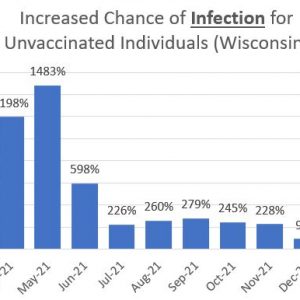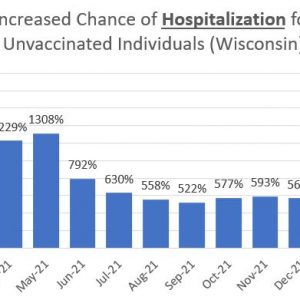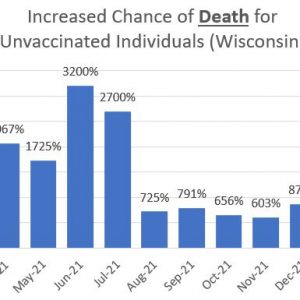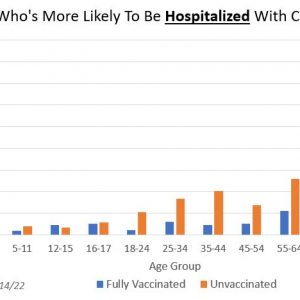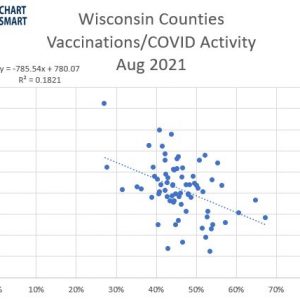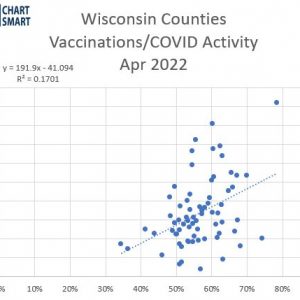
Dane County has the highest vaccination rate AND the highest Covid-19 activity level in the state
Positive correlation shows counties with higher vaccination rates have higher disease activity levels
Vaccinated children are 2.4 times more likely to catch Covid-19 than their unvaccinated peers
Vaccinated children from the ages of 12-15 are more likely to be hospitalized than their unvaccinated peers
Among all ages, vaccinated individuals are slightly more likely to catch Covid-19 than the unvaccinated
CDC Data shows the boosted are twice as likely to catch Covid-19 as those only fully vaccinated
Apr. 25, 2022
By Bill Osmulski
DHS’ latest overhaul of its Covid-19 dashboard reveals a massive shift in Covid-19 vaccine trends, but removes key datasets needed to understand it.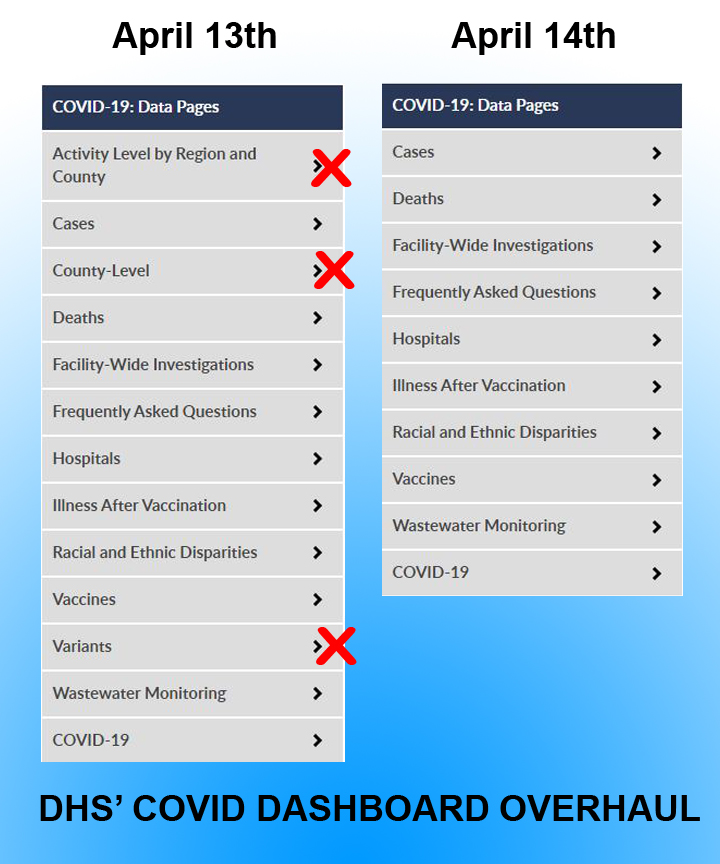
DHS eliminated 3 of 12 webpages that contained detailed historic datasets and updated its vaccine breakthrough page for the first time in three months.
The changes took place on Apr. 14th, which was Holy Thursday and, for many people, the start of a long holiday weekend. There was no press conference, and only a brief press release accompanied the overhaul.
“As the COVID-19 pandemic evolves, we are continuously adapting to changes and highlighting the data and information that is most useful for individuals and families to use in safeguarding their own health, and for our partners to use to make informed decisions for their communities,” DHS Secretary-Designee Karen Timberlake said in a news release.
In Wisconsin, 61% of residents (over the age of 5) are fully vaccinated, and 33.9% have received an additional booster. Nationwide, 70.2% of the population (over the age of 5) is fully vaccinated, and 45.5% have received an additional booster.
Dr. Anthony Fauci and other scientists originally said 60 – 70% of the population needed to be vaccinated or acquire other resistance to achieve herd immunity from Covid-19. However, they started to slide that number up to 80% in late 2020.
Troubling Vaccine Health Outcomes
DHS’s new vaccine breakthrough data shows there is almost no difference in the infection rates among vaccinated and unvaccinated (including not fully vaccinated) populations. The raw data shows vaccinated individuals are slightly more likely to catch Covid-19 than unvaccinated individuals. The age-adjusted data shows unvaccinated individuals are slightly more likely to catch Covid-19 than fully vaccinated individuals. (DHS does not break down the results for partially vaccinated individuals).
When DHS last reported that data in January, the rate of infection among unvaccinated individuals was double that of the vaccinated. The difference between the vaccinated and unvaccinated populations’ outcomes has been shrinking for months. Back in April, the unvaccinated population’s infection rate was 1200% higher than that of the vaccinated population.
Hospitalization and death rates between the two populations is also narrowing. The hospitalization rate among the unvaccinated population is 143% higher than among the vaccinated population. In May 2021, the rate was 1308% higher.
The death rate among the unvaccinated population is 220% higher than among the vaccinated population. In June 2021, the rate was 3200% higher.
The differences in health outcomes varies greatly depending on an individuals’ age. For example, children 5-11 who are vaccinated are 2.4 times more likely to catch Covid-19 than an unvaccinated child.
The highest infection rate is 241.1 per 100,000 among unvaccinated individuals over the age of 65. It’s 173.7 per 100,000 for their vaccinated peers. When all age groups are combined, DHS’ data shows a slightly higher rate of infection among the vaccinated than the unvaccinated: 198.2 compared to 196 per 100,000. DHS calls that the “crude rate,” and prefers the age-adjusted rate, which shows a slightly higher infection rate for the unvaccinated population.
Using that same “crude rate,” unvaccinated individuals are more likely to be hospitalized with Covid-19 in all age groups except those aged 12-15. Children in that age group are 0.7 times more likely to be hospitalized than their unvaccinated peers.
Unvaccinated individuals are more likely to die from Covid-19 in all age groups. Those over the age of 65 who are unvaccinated are 2.2 times more likely to be hospitalized and 3.2 times more likely to die from Covid-19.
DHS also directs users to the CDC’s illness after vaccination webpage for more information. The CDC’s data covers 60% of the US population in 27 different regions, and includes booster status. It shows people who took the booster are twice as likely to catch Covid-19 as those who only took the initial series, and unvaccinated people are almost twice as likely to catch Covid-19 as those who were boosted. The most recently reported rates of infection per 100,000 for the unvaccinated is 73.5, for the fully vaccinated is 22.3, and for the fully-vaccinated and boosted is 40.8.
WMTV-TV asked DHS why the gaps are narrowing between vaccinated and unvaccinated populations. DHS said the omicron variant is to blame.
“They expect to see more fully vaccinated people testing positive as a result of the mutation, but added today’s vaccines still protect against severe COVID-19 cases, hospitalizations, and death from the variant,” WMTV-TV reported.
Coincidently, DHS took down its variant webpage during the overhaul.
Local Vaccine Efficacy Trends
Another one of the webpages that DHS eliminated contained critical information needed to understand this changing trend. The “Activity Level by Region and County” page contained detailed county-level data with a user-friendly graphic interface and long-range historic data.
DHS now directs users to the CDC’s website, where they have to download a bulk datafile that only contains two months of data. The MacIver Institute used that data from the CDC to update its analysis comparing county vaccination rates (on the first of each month) and activity levels (approximately two weeks later). There’s been a dramatic reversal of the vaccine’s impact on public health outcomes.
The correlation between vaccination rates and covid activity levels has ranged from non-existent to moderate. A strong r-value is 1 or -1, and a strong r-squared value is 1. By both measures, zero indicates no correlation. The MacIver analysis found r-values ranging from -0.43 to 0.42, and r-squared values as high as 0.18 over the past year.
In August, there was a negative correlation between vaccination rates and covid activity levels. The more people who were vaccinated in a county, the fewer Covid-19 cases there were in that county.
Since January, there’s been a positive correlation between vaccination rates and covid activity levels. The more people who are vaccinated in a county, the more Covid-19 cases there are.
As of this month, Dane County has the highest vaccination rate and the highest Covid-19 activity levels in Wisconsin. On Apr. 1st, 79% of Dane County residents were fully vaccinated, and two-weeks later, the county was experiencing 184 cases per 100,000 residents. It also has the highest boosted rate in the state at 47.7%.
Last month, Dane County had the highest vaccination rates and the second highest disease activity levels. Only Green County, with 63% of its residents fully vaccinated had a higher activity level.
Dane County is now recommending everyone get a booster, despite the CDC data that shows people with the booster are even more likely to catch Covid than those who are fully vaccinated.
Conclusions
First of all, the decreasing rates of infection, hospitalization, and death among both vaccinated and unvaccinated populations suggests Covid-19 is naturally becoming weaker. At the same time, vaccine efficacy also seems to be diminishing.
Many of the differences between vaccinated and unvaccinated health outcomes are minor and temporary. They could be interpreted as negligible or anomalies. However, some of the trends are distinct and/or consistent, warranting further investigation and debate. For example, why are vaccinated children 2.4 times more likely to catch Covid-19 than their unvaccinated peers? Why have counties with higher vaccination rates seen higher disease levels for four months straight? Finally, why did DHS completely overhaul its website just as these trends emerged and right at the start of an extended holiday weekend?
